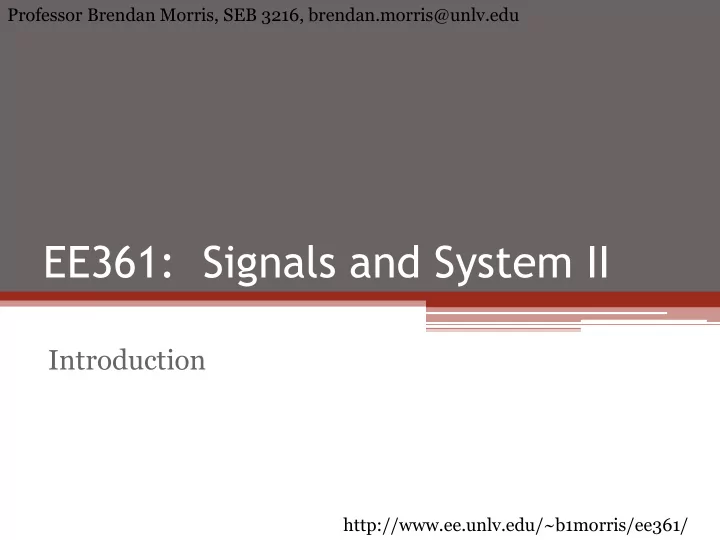

Professor Brendan Morris, SEB 3216, brendan.morris@unlv.edu EE361: Signals and System II Introduction http://www.ee.unlv.edu/~b1morris/ee361/
2 Class Website • http://www.ee.unlv.edu/~b1morris/ee361/ • This will have the most up-to-date information about the class. ▫ Weekly schedule ▫ Tentative dates for exams ▫ Homework assignments (first 4 posted already) • Syllabus ▫ http://www.ee.unlv.edu/~b1morris/ee361/docs/s yllabus.pdf
3 Instructor • Dr. Brendan Morris • Office: SEB 3216 (see reception desk) • Office Hours (tentative) ▫ MTuWTh 16:00-17:00 ▫ Email for appointments at other times ▫ Poll: Office hours work?
4 Important Dates • Lecture ▫ TuTh 14:30-15:45, CBC C217 • Final ▫ Th Dec. 14, 15:10-17:10 ▫ Look up your final exam schedule now to determine conflicts. I must be notified within the first month or I will not be able to help • Quizzes, Midterms (tentative) ▫ 9/19, 10/12, 11/21
5 Textbook Required Signals and Systems, A.V. Schaum's Outlines: Schaum's Outlines: Oppenheim, A.S. Willsky, Signals and Systems, H. Probability, Random and S.H. Nawab, 2nd Hsu, Variables, and Random Edition, ISBN: 978-0071829465 Processes, H. Hsu, ISBN: 0-13-814757-4 [link] ISBN: 978-0071822985 [link] First half of course Second half of course (Chapters 1-5) (Notice these are available online)
6 Useful Texts • Oppenheim and Willsky is expensive and you may not have it if you did not take ee360 with me ▫ May only need Schaum’s Outlines: Signals and Systems • Recommended texts ▫ Schaum's Outlines: Probability and Statistics, M Spiegel, ISBN: 9780071795579 [link] ▫ Linear Systems and Signals, B.P. Lathi, 2nd Edition, ISBN: 978-0-19-515833-5
7 Grading • Quizzes (2): 20% • Midterm: 25% • Final: 30% • Homework: 25% • Homework will include Matlab programming problems. Students may work together in study groups but all assignments must be completed individually. • Homework will be due in class on the designated date. No late homework will be accepted unless prior notification and arrangements are made. • As a university student it is your responsibility to conduct yourself ethically and with integrity as described in the Academic misconduct Policy. Cheating and plagiarism will not be tolerated. Any student caught cheating will be given an F grade. (http://studentconduct.unlv.edu/misconduct/policy.html)
8 Catalog Description • Stochastic and deterministic signals and linear systems. Analog and discrete Fourier Series, analog and discrete Fourier transforms, basic probability theory, stochastic processes, stochastic signals and linear systems. • Prerequisites ▫ EE360 and MATH 432
9 Questions?
10 Signals and Systems I Recap • Signals – qualitative descriptions of physical phenomena ▫ Represent a pattern of variation • System – qualitative description of a physical process to transform an input signal to an output signal ▫ The system is a “black box” • E.g. Physical system Abstract system 𝑤 𝑑 𝑢 𝑤 𝑡 (𝑢) T 𝑗(𝑢)
11 Signals • This course deals with signals that are a function of one variable ▫ Most often called “time” • Continuous time (CT) signal ▫ 𝑦 𝑢 , 𝑢 ∈ ℝ ▫ Time is a real valued (e.g. 1.23 seconds) • Discrete time (DT) signal ▫ 𝑦 𝑜 , 𝑜 ∈ ℤ ▫ Time is discrete (e.g. 1 or 5) Signal is a sequence and 𝑜 is the location within the sequence
12 Basic System Properties • Memoryless ▫ Output does not depend on past values • Invertible ▫ Another system exists that accepts 𝑧(𝑢) as input and returns 𝑦(𝑢) • Causal ▫ Output only depends on past or present values ▫ Realizable system since it does not need future values Implement non-causal systems with delays • Stable ▫ BIBO criterion: bounded input results in bounded output • Linear ▫ Given 𝑈 𝑦 𝑢 → 𝑧(𝑢) ▫ 𝑏𝑦 1 𝑢 + 𝑐𝑦 2 𝑢 → 𝑏𝑧 1 𝑢 + 𝑐𝑧 2 (𝑢) • Time Invariant ▫ Time shift on input results in same time shift on output ▫ 𝑈 𝑦 𝑢 − 𝑢 0 → 𝑧 𝑢 − 𝑢 0
13 LTI System • Linear and time-invariant systems 𝑦[𝑜] 𝑧[𝑜] LTI 𝜀[𝑜] ℎ[𝑜] ▫ Impulse response ℎ 𝑜 completely specifies input/output relationship 𝑧 𝑜 = 𝑦 𝑜 ∗ ℎ 𝑜 𝑦[𝑜] ℎ[𝑜] ∞ = 𝑦 𝑙 ℎ 𝑜 − 𝑙 𝑙=−∞ ∞ = ℎ 𝑙 𝑦[𝑜 − 𝑙] 𝑙=−∞
14 LTI Properties • Memoryless ▫ ℎ 𝑢 = 𝑏𝜀(𝑢) , where 𝑏 is a constant • Invertible 𝑦[𝑜] ℎ[𝑜] 𝑧[𝑜] [𝑜] 𝑥 𝑜 = 𝑦[𝑜] ▫ ℎ 𝑜 ∗ 𝑜 = 𝜀 𝑜 • Causal ▫ ℎ 𝑢 = 0, 𝑢 < 0 ▫ Does not depend on future input – see convolution integral • Stable ▫ Absolutely integrable/summable ∞ ▫ ℎ 𝜐 𝑒𝜐 < ∞ −∞
15 Eigen Property • Eigen function (signal) for an LTI system is a signal for which the output is the input times a (complex) constant 𝑦 𝜇 (𝑢) ℎ(𝑢) 𝑧 𝑢 = 𝜇𝑦 𝜇 (𝑢) eigenvalue • CT: 𝑓 𝑡𝑢 → 𝐼 𝑡 𝑓 𝑡𝑢 ▫ 𝐼(𝑡) – eigenvalue from Laplace Transform (system/transfer function) • DT: 𝑨 𝑜 → 𝐼 𝑨 𝑨 𝑜 ▫ 𝐼 𝑨 - eigenvalue from Z-transform (system/transfer function)
Recommend
More recommend